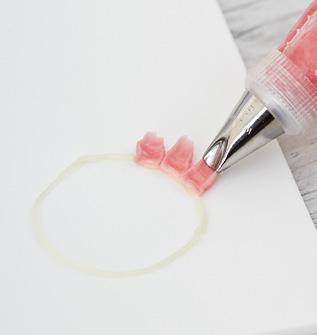The Contemporary Buttercream Bible (20 page)
Read The Contemporary Buttercream Bible Online
Authors: Christina Ong Valeri Valeriano

common point and that there isn’t a big gap in the
centre (C).
C
3 Cut the tip off a piping bag and use yellow-tinted
buttercream to pipe dots in the centre of each of the flowers (D).
225
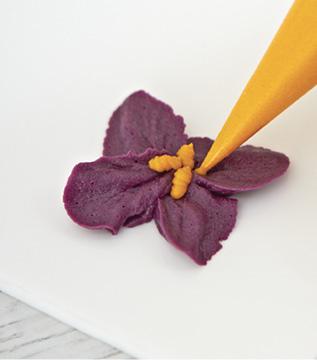
D
4 Pipe some leaves using a leaf nozzle (see
Sunflower and Leaves) (E).
226
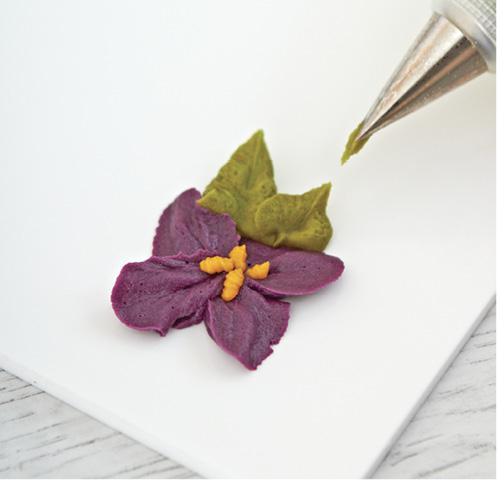
E
Tip
Try using the two-tone effect described in the
Ruffles section of Piping Textures and
Patterns. Since these flowers use a small
amount of buttercream, they are not heavy so
you can pipe them on the sides of the cake.
Just make sure you use a bit of pressure as
you pipe so that they stick to the cake.
227
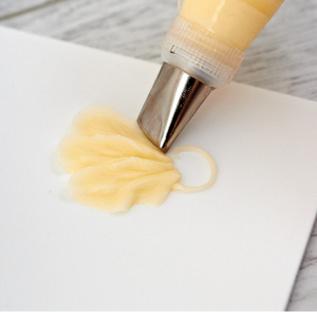
Daisy
1 Pipe a small guide circle, then using a small petal nozzle (Wilton 104), position the nozzle flat to the
surface of the cake with the wide end facing towards
you. Continuously squeeze the piping bag with even
pressure and follow a long U-shape, but without the
space in the middle of the ‘U’, until you create a
small petal.
2 Repeat the same process and pipe more petals
(A), allowing them to overlap a little, and making
sure that they all meet at one common point and
don’t leave a big gap in the centre. Continue until
you have completed the circle of petals (B).
A
228
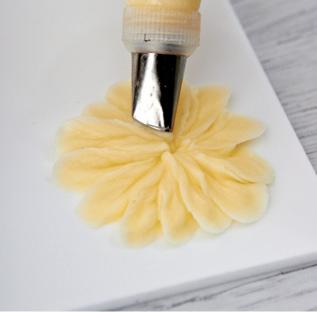
B
3 To pipe the centre of the flower, cut the tip off the piping bag and, using yellow-tinted buttercream,
pipe in a continuous circular motion with even
pressure, until the spiral creates a dome (C).
229
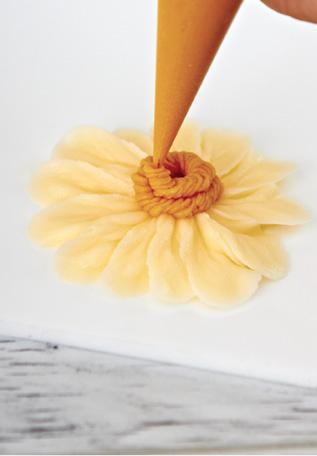
C
4 Pipe some leaves using a leaf nozzle (see
Sunflower and Leaves) (D).
230
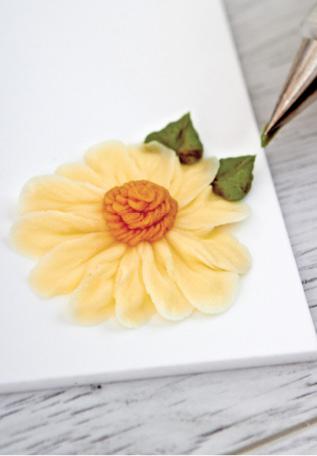
D
Tip
For the daisy, your nozzle needs to be
completely flat on the surface and you must
start from the centre of the flower. Just
remember these three words: squeeze, up and
down! For the flower centre, you can either
pipe a dome or use chocolates or candies for
an interesting touch.
231
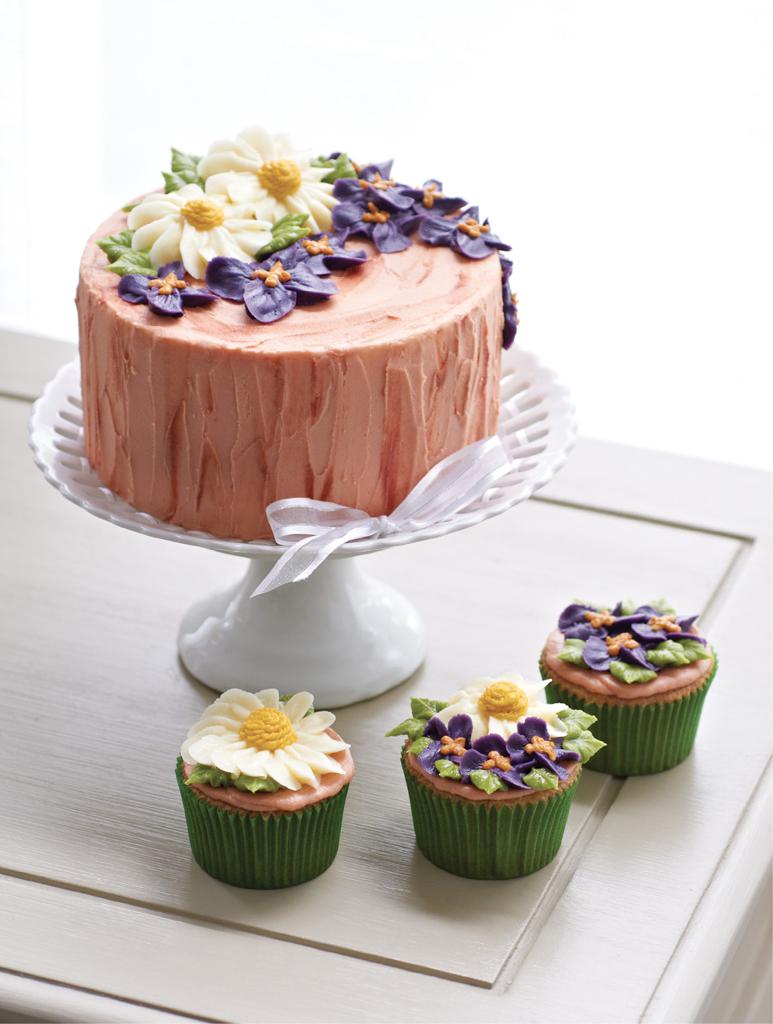
To create this cake…
• 15 × 10cm (6 × 4in) round cake
• 1.3–2kg (3lb–4lb 8oz) buttercream
232
• Paste
colours:
light
chestnut
(Sugarflair
Chestnut), dark chestnut (Sugarflair Chestnut),
violet, (Sugarflair Grape Violet), light green
(Sugarflair
Gooseberry),
orange
(Sugarflair
Egyptian Orange), yellow (Sugarflair Autumn Leaf)
• Piping bags
• Small petal nozzle (Wilton 104)
• Leaf nozzle (Wilton 352)
• Palette knife
• Scissors
• Cake stand or covered cake board
Crumb coat the cake (see Crumb Coating in
Buttercream Basics) and place on a stand or
covered cake board. Cover the cake with 300–400g
(101⁄2–14oz) of light chestnut buttercream and use a
palette knife and 100–200g (31⁄2–7oz) of dark
chestnut buttercream to create a streaked effect
(see Blending in Palette Knife Techniques). Colour
the remaining buttercream in the following
quantities: 150–250g (51⁄2–9oz) each of violet, light green and yellow, 250–350g (9–12oz) orange and
leave 200–300g (7–101⁄2oz) uncoloured. Pipe the
daisies first with plain petals and yellow centres,
233
then the violets with violet petals and orange
centres, following the relevant tutorials above. Pipe some leaves between the flowers in light green (see
Sunflower and Leaves).
234
Chrysanthemum and Daffodil
Chrysanthemums are mostly known for their
vibrant colours and shape. Adding them gives a
much bolder and more daring look to a cake than
some of the more conservative flowers. Creating
chrysanthemums involves a repeated piping action
which delivers excellent results. Daffodils too are
very popular flowers, ideal for a spring time cake,
and despite the ‘trumpet’ at their centre they
actually involve a very easy piping technique.
235

Daffodils are one of the first signs that spring has
arrived, while chrysanthemums bloom at the end of
summer, so these flowers are plucked from
236
different seasons – but in cake decorating you’re
the boss and you can do what you like! No one
could argue that the sunny daffodil and the rich and
exciting colours of the chrysanthemum don’t belong
together on a pretty cake stand, especially when
they are presented in these cute spotted cups. For
these two flowers, the bigger they are the better
because the form is more obvious when the petals
are larger. Chrysanthemum nozzles come in
different sizes, so go ahead and experiment with
them.
Chrysanthemum
1 Start by piping a guide circle. Using a
chrysanthemum nozzle (Wilton 81), position the
nozzle at a 20 to 30 degree angle with the curved
end down and against the guide circle. Gently
squeeze the piping bag with even pressure while
pulling out with a quick stroke until you reach the
desired length of petal – about 5mm (1⁄4in). Repeat
the process to create one layer of petals (A).
237
